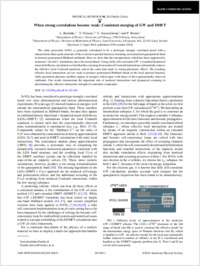When strong correlations become weak: Consistent merging of $GW$ and DMFT
- Boehnke, Lewin Department of Physics, University of Fribourg, Switzerland
- Nilsson, Fredrik Department of Physics, Division of Mathematical Physics, Lund University, Sweden
- Aryasetiawan, Ferdi Department of Physics, Division of Mathematical Physics, Lund University, Sweden
- Werner, Philipp Department of Physics, University of Fribourg, Switzerland
-
10.11.2016
Published in:
- Physical Review B. - 2016, vol. 94, no. 20, p. 201106
English
The cubic perovskite SrVO3 is generally considered to be a prototype strongly correlated metal with a characteristic three-peak structure of the d-electron spectral function, featuring a renormalized quasiparticle band in between pronounced Hubbard sidebands. Here we show that this interpretation, which has been supported by numerous “ab initio” simulations, has to be reconsidered. Using a fully self-consistent GW + extended dynamical mean-field theory calculation we find that the screening from nonlocal Coulomb interactions substantially reduces the effective local Coulomb repulsion, and at the same time leads to strong plasmonic effects. The resulting effective local interactions are too weak to produce pronounced Hubbard bands in the local spectral function, while prominent plasmon satellites appear at energies which agree with those of the experimentally observed sidebands. Our results demonstrate the important role of nonlocal interactions and dynamical screening in determining the effective interaction strength of correlated compounds.
- Faculty
- Faculté des sciences et de médecine
- Department
- Département de Physique
- Language
-
- English
- Classification
- Physics
- License
-
License undefined
- Identifiers
-
- RERO DOC 278705
- DOI 10.1103/PhysRevB.94.201106
- Persistent URL
- https://folia.unifr.ch/unifr/documents/305312
Statistics
Document views: 114
File downloads:
- pdf: 231
